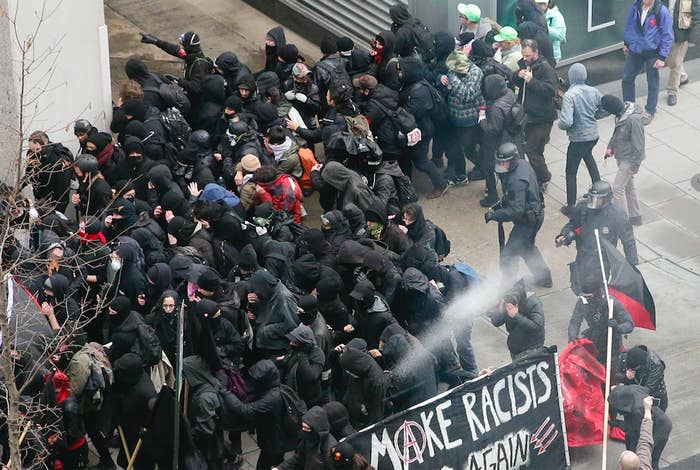
Metropolitan Police Department Detective Greggory Pemberton has worked on just one case since Jan. 21, 2017: the mass arrest of more than 200 people charged with rioting in Washington, DC, during President Donald Trump’s inauguration.
Pemberton told a jury this week that he spent most of this year focused not only on one case, but primarily on one task: sifting through hundreds of hours of video footage that captured the roughly half-hour period on Jan. 20 when prosecutors say the defendants rioted.
The jury saw the fruits of Pemberton’s labors this week, with prosecutors for the first time presenting evidence that they contend ties individual defendants to the violence on Jan. 20. The jury saw video clips and screenshots broken down to highlight small details — a white zipper, a green water bottle, a purple backpack — that prosecutors hope will distinguish each of the defendants from the sea of black-clad demonstrators that day.
The government’s presentation demonstrated how prosecutors and police can pick apart a “black bloc” — a protest strategy particularly associated this year with the antifa movement in which participants dress in dark clothes and otherwise mask their appearance to thwart identifications by law enforcement.
The trial for the first set of Jan. 20 arrestees to go before a jury is now in its third week. Police officers who were at a Jan. 20 demonstration billed as an “anti-capitalist” and “anti-fascist” march previously testified that they couldn’t tell which of the hundreds of black-clad marchers broke the windows of stores and cars. People would run out, smash glass, and then blend back in with the crowd, officers said.
But Pemberton’s months of analysis attempted to show that with enough footage — in this case, from police body cameras, surveillance videos, and video recorded by people involved in or observing the protests — and enough time, it is possible for the government to tease apart a black bloc.
Whether and to what extent the government can show that individual defendants were involved in the violence on Jan. 20 has been a major point of contention since the arrests. Defense lawyers unsuccessfully argued that the charges should be dismissed because the government for the most part did not specify in charging papers what each of the defendants allegedly did on Jan. 20 that made them criminally responsible. Defense lawyers have also argued that many arrestees were involved in protected First Amendment speech, and were wrongly being held responsible for the bad actions of a few.
The first trial group, which includes six defendants, faces eight charges: one count of inciting or urging a riot, a felony; five counts of property destruction, also felonies; and two misdemeanor charges for engaging in a riot and conspiracy to riot. The felony charges carry maximum penalties of 10 years in jail.
The government’s theory is that defendants didn’t need to personally break a window to be liable for the riot in its totality. None of the videos that the jury saw on Wednesday focusing on individual defendants’ conduct on Jan. 20 showed them engaging in property destruction.
Assistant US Attorney Jennifer Kerkhoff, the lead prosecutor, presented poster boards on Wednesday with screenshots of images from videos analyzed by Pemberton that appeared to show certain defendants at various stages of the demonstration.
On one board, the jury saw photos of a person dressed all in black: black head covering, black face mask, black sweatshirt, black pants, black backpack. The photos were screenshots from videos, Pemberton testified. Arrows on each photo noted distinguishing features — white strings hanging from the sweatshirt, a white zipper, and a water bottle stored in a pocket of the backpack. The photos depicted the person at different locations along the route that demonstrators took before they were stopped by police and arrested at 12th and L Streets in Northwest Washington.
Kerkhoff then showed the jury a compilation of video clips the screenshots were taken from, highlighting in each clip the person — often in a crowd of many other people wearing black — wearing the black sweatshirt with white strings and a white zipper.
Finally, Kerkhoff showed a PowerPoint presentation that featured a map of downtown Washington and icons representing the locations where the government said each of the video clips were recorded. Jurors would have that interactive PowerPoint when they deliberate, Kerkhoff said.
Kerkhoff made three similar presentations on Wednesday — a photo board, video clip reel, and interactive PowerPoint — and had started on a fourth when the judge concluded the trial for the week. Pemberton is expected to resume his testimony on Dec. 11.
The boards and videos did not identify which defendant is supposedly depicted. The government wanted to include field arrest photos and mugshots identifying defendants on the boards, but the judge ruled before the jury was seated on Wednesday that couldn’t happen. Judge Lynn Leibovitz explained that she had already ruled that although Pemberton could testify that a set of photos included certain common elements — an article of clothing, for instance — he could not make the jump to positively identifying the person in that set of photos as a defendant.
Still, the implication of each board was clear. Pemberton at one point testified that he saw one of the defendants, Oliver Harris, in the courthouse during the trial with a backpack that looked like a backpack shown in photos on one of the boards.
Police arrested 234 people on rioting charges, but between dismissals by the government and guilty pleas, 194 cases are still pending. The defendants are being tried in groups. The first trial for the six defendants started on Nov. 20, and more trials are scheduled for December and throughout 2018.

